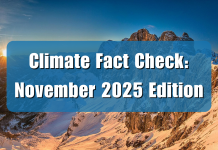Rolling Stone this week added its voice to a number of media outlets, like Phys.org and Business Insider, falsely asserting a connection between climate change and COVID-19. In reality, if a modestly warming Earth has any impact on viruses and pandemics, it is to make them less likely and less severe.
In the article, “How Climate Change Is Ushering in a New Pandemic Era,” the author writes, “[a] warming world is expanding the range of deadly diseases and risking an explosion of new zoonotic pathogens from the likes of bats, mosquitoes, and ticks.” The article is long on assertions, touching anecdotes, and personal stories but short on facts and scientific evidence.
Transmissible diseases like the flu and the coronavirus are far more prevalent and deadly during the late-fall, winter, and early spring, when the weather is cold and damp, rather than in the summer months when it is warm and dry. That is the primary reason that flu season runs from fall through early spring, and then peters out. Similarly, colds are called colds because they are less common in the summer, as well.
Historically, we know that the Black Plague arose and ran rampant in Europe and elsewhere during the Little Ice Age.
Chapter 7 of the Non-governmental International Panel on Climate Change’s report of Climate Change Reconsidered: Biological Impacts details the results of dozens of peer-reviewed studies and reports showing premature deaths from illness and disease are far more prevalent during colder seasons and colder climate eras rather than during warmer seasons and warmer climate eras.
In 2010, BBC health correspondent Clare Murphy analyzed mortality statistics from the UK’s Office of National Statistics from 1950 through 2007 and found, “For every degree the temperature drops below 18C [64 degrees Fahrenheit], deaths in the UK go up by nearly 1.5 percent.”
U.S. Interior Department analyst Indur Goklany studied official U.S. mortality statistics and found similar results. According to official U.S. mortality statistics, an average of 7,200 Americans die each day during the months of December, January, February, and March, compared to 6,400 each day during the rest of the year.
In an article published in the Southern Medical Journal in 2004, W. R. Keatinge and G. C. Donaldson noted, “Cold-related deaths are far more numerous than heat-related deaths in the United States, Europe, and almost all countries outside the tropics, and almost all of them are due to common illnesses that are increased by cold.”
More recently, in a study published in the peer-reviewed medical journal Lancet in 2015, researchers examined health data from 384 locations in 13 countries, accounting for more than 74 million deaths—a huge sample size from which to draw sound conclusions. The researchers found cold weather, directly or indirectly, killed 1,700% more people than hot weather. No, that is not a typo – 1,700% more people die from cold temperatures than warm or hot temperatures.
And Rolling Stone’s assertion that climate change will cause vector-borne diseases to spread to new regions is refuted by the vast body of scientific literature detailed in Chapter Four of Climate Change Reconsidered II: Fossil Fuels.
Studies from throughout the world repeatedly find any link between global warming and the spread of malaria, Dengue fever, West Nile virus, and other vector-borne diseases, are either grossly overstated or outright false.
For example, a 2010 study in the peer-reviewed science journal Nature:
compared historical and contemporary maps of the range and incidence of malaria and found endemic/stable malaria is likely to have covered 58% of the world’s land surface around 1900 but only 30% by 2007. They report, ‘even more marked has been the decrease in prevalence within this greatly reduced range, with endemicity falling by one or more classes in over two-thirds of the current range of stable transmission.’ They write, ‘widespread claims that rising mean temperatures have already led to increases in worldwide malaria morbidity and mortality are largely at odds with observed decreasing global trends in both its endemicity and geographic extent.’
Also, in a 2008 article in the Malaria Journal, Pasteur Institute of Paris professor Paul Reiter wrote:
“Simplistic reasoning on the future prevalence of malaria is ill-founded; malaria is not limited by climate in most temperate regions, nor in the tropics, and in nearly all cases, ‘new’ malaria at high altitudes is well below the maximum altitudinal limits for transmission, [continuing] future changes in climate may alter the prevalence and incidence of the disease, but obsessive emphasis on ‘global warming’ as a dominant parameter is indefensible; the principal determinants are linked to ecological and societal change, politics and economics.”
The COVID-19 pandemic is scary enough without pop-media outlets like Rolling Stone hyping unwarranted fears of a link to climate change. Rolling Stone should stick to what it does best, covering music and pop culture. When it comes to science, Rolling Stone is about as knowledgeable and authoritative as Madonna.

























‘Rolling Stone should stick to what it does best, covering music and pop culture. When it comes to science, Rolling Stone is about as knowledgeable and authoritative as Madonna.’
What do you think the global warming scam is? A pop culture generated meme, based on faked science, faked data, using pop icons to sell the Kool-Aid™ to the MTV crowd.
BTW, you paid no attention that the FACT that the Wuhan/Fort Detrick University of North Carolina Chapel Hill Coronavirus gain-of-function was created in the lab.
Plandemic II https://www.bitchute.com/video/7RxTeGEXbaEQ/